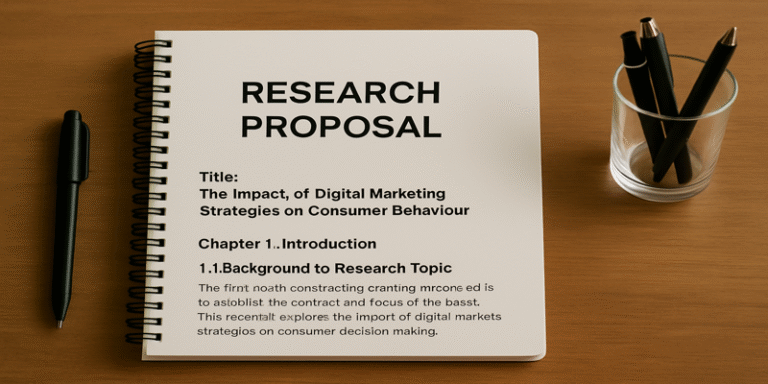Title: The Impact of Digital Marketing Strategies on Consumer Behaviour
Chapter 1: Introduction
1.1 Background to Research Topic
The initial step in developing a strong research proposal is to understand the core of the research topic. This research explores the impact of digital marketing strategies on consumer behaviour. With the growing digital transformation, businesses are increasingly shifting their marketing strategies towards digital platforms such as social media, search engines, and e-commerce sites (Chaffey & Ellis-Chadwick, 2019; Strauss & Frost, 2016). The rise of these platforms has transformed traditional marketing methods, prompting the need to study how consumers interact with brands in the digital space (Tiago & Veríssimo, 2014).
1.2 Background to Research Organisation
This research will focus on a mid-sized e-commerce company, TechTraders, which primarily sells electronic gadgets. Founded in 2015, TechTraders has rapidly expanded in the digital space and has a strong online presence. The company’s digital marketing strategies range from social media campaigns to influencer marketing and pay-per-click (PPC) advertising (Charlesworth, 2020). This study will evaluate how TechTraders’ digital marketing efforts influence consumer purchasing decisions.
1.3 Research Rationale
The rationale for this research stems from the increasing importance of digital marketing in driving business success. According to Kotler et al. (2017), businesses that effectively use digital marketing can significantly improve customer engagement and sales. However, there is limited empirical research on how specific strategies (e.g., PPC, social media) influence consumer behaviour in mid-sized companies (Kingsnorth, 2019). This study aims to fill this research gap and provide practical insights for businesses.
1.4 Research Aim
The aim of this research is to assess the impact of digital marketing strategies, particularly social media and PPC advertising, on consumer purchasing decisions at TechTraders.
1.5 Research Objectives
- To examine the effectiveness of social media campaigns in influencing consumer behaviour.
- To analyse the role of PPC advertising in driving traffic and sales for TechTraders.
- To explore how digital marketing strategies contribute to brand loyalty and repeat purchases.
Chapter 2: Research Methodology
2.1 Research Philosophies/Paradigms
The chosen research philosophy is interpretivism, as it seeks to understand how consumers perceive and react to digital marketing strategies (Saunders et al., 2019). Interpretivism focuses on subjective experiences, making it ideal for studying consumer behaviour. In contrast, positivism, which emphasises objectivity, is less suited here because consumer decision-making involves complex, subjective responses (Collis & Hussey, 2021).
2.2 Research Design
The study will adopt an exploratory design to investigate the dynamic relationship between digital marketing strategies and consumer behaviour. Since digital marketing is constantly evolving, an exploratory approach provides a flexible framework for identifying trends and emerging consumer patterns (Robson & McCartan, 2016; Bell et al., 2018).
2.3 Research Approach
A deductive approach will be employed. Deductive reasoning starts with established theories and uses them to guide empirical research (Bryman & Bell, 2015). This is appropriate because the study aims to test existing theories of digital marketing and consumer behaviour in a new context (i.e., TechTraders).
2.4 Research Strategy/Method
The research strategy will be a case study. This allows an in-depth exploration of how digital marketing strategies are implemented at TechTraders and how they influence consumer behaviour (Yin, 2018). The case study method is suitable for generating contextualised insights (Stake, 1995).
2.5 Research Methodology
The study will adopt a qualitative methodology. Qualitative research allows for in-depth interviews with consumers and marketing personnel, exploring their attitudes, perceptions, and behaviours (Creswell, 2014; Silverman, 2020). This approach generates rich insights into the subjective experience of consumers.
2.6 Research Techniques/Tools
The study will use semi-structured interviews as the primary data collection tool. Interviews with TechTraders’ consumers will provide insights into their responses to digital campaigns (Gill et al., 2008). Semi-structured interviews enable flexibility in questioning, encouraging participants to share detailed experiences.
2.7 Sampling Approach
A non-probability purposive sampling approach will be used. Since the study aims to understand specific consumer experiences, purposive sampling allows selection of participants who have engaged with TechTraders’ digital marketing efforts (Etikan et al., 2016). A sample size of 20 consumers is proposed, sufficient for generating in-depth qualitative data (Guest et al., 2020).
2.8 Ethical Considerations
Ethical considerations include informed consent, confidentiality, and data protection. Participants will be briefed on the purpose of the study, and consent forms will be distributed. Data will be anonymised to protect identities and stored in compliance with GDPR regulations (Babbie, 2016; Israel & Hay, 2006).
Chapter 3: Literature Review (Selected Sources)
- Chaffey, D., & Ellis-Chadwick, F. (2019). Digital Marketing: Strategy, Implementation, and Practice. Pearson.
- Kotler, P., Keller, K. L., & Brady, M. (2017). Marketing Management. Pearson.
- Kingsnorth, S. (2019). Digital Marketing Strategy: An Integrated Approach to Online Marketing. Kogan Page.
- Strauss, J., & Frost, R. (2016). E-Marketing. Routledge.
- Tiago, M. T. P. M. B., & Veríssimo, J. M. C. (2014). Digital marketing and social media: Why bother? Business Horizons, 57(6), 703–708.
- Saunders, M., Lewis, P., & Thornhill, A. (2019). Research Methods for Business Students. Pearson.
Chapter 4: Timescale[
| Task | Time Frame |
| Initial Research & Proposal | Weeks 1–3 |
| Literature Review | Weeks 4–6 |
| Data Collection (Interviews) | Weeks 7–9 |
| Data Analysis | Weeks 10–11 |
| Final Draft Writing | Weeks 12–14 |
| Final Submission | Week 15 |
References
Babbie, E. R. (2016). The Practice of Social Research. Cengage Learning.
Bell, E., Bryman, A., & Harley, B. (2018). Business Research Methods. Oxford University Press.
Bryman, A., & Bell, E. (2015). Business Research Methods. Oxford University Press.
Charlesworth, A. (2020). Digital Marketing: A Practical Approach. Routledge.
Collis, J., & Hussey, R. (2021). Business Research: A Practical Guide for Undergraduate and Postgraduate Students. Palgrave Macmillan.
Creswell, J. W. (2014). Research Design: Qualitative, Quantitative, and Mixed Methods Approaches. Sage.
Etikan, I., Musa, S. A., & Alkassim, R. S. (2016). Comparison of convenience sampling and purposive sampling. American Journal of Theoretical and Applied Statistics, 5(1), 1–4.
Gill, P., Stewart, K., Treasure, E., & Chadwick, B. (2008). Methods of data collection in qualitative research: Interviews and focus groups. British Dental Journal, 204(6), 291–295.
Guest, G., Namey, E., & Chen, M. (2020). A simple method to assess and report thematic saturation in qualitative research. PLOS ONE, 15(5).
Israel, M., & Hay, I. (2006). Research Ethics for Social Scientists. Sage.
Kingsnorth, S. (2019). Digital Marketing Strategy. Kogan Page.
Robson, C., & McCartan, K. (2016). Real World Research. Wiley.
Saunders, M., Lewis, P., & Thornhill, A. (2019). Research Methods for Business Students. Pearson.
Silverman, D. (2020). Interpreting Qualitative Data. Sage.
Stake, R. E. (1995). The Art of Case Study Research. Sage.
Strauss, J., & Frost, R. (2016). E-Marketing. Routledge.
Tiago, M. T. P. M. B., & Veríssimo, J. M. C. (2014). Digital marketing and social media: Why bother? Business Horizons, 57(6), 703–708.
Yin, R. K. (2018). Case Study Research and Applications: Design and Methods. Sage.









